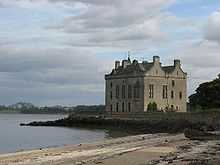Barnbougle Castle

Barnbougle Castle is a much-altered tower house on the south shore of the Firth of Forth, between Cramond and South Queensferry. It lies within the Dalmeny Estate, and is the property of the Earl of Rosebery. It is about 0.33 miles (0.53 km) north of Dalmeny House, the main house on the estate. Although its history goes back to the 13th century, the present castle is the result of rebuilding in 1881 by the 5th Earl of Rosebery, who served as the British Prime Minister from 1894–1895.
History
Barnbougle was owned by the Mowbray, or Moubray, family, a Norman family who were also lords of Dalmeny and Inverkeithing.[1] The first building was a thirteenth-century tower house, constructed by Philip Mowbray.[citation needed] In 1615 the Mowbrays sold Barnbougle to Sir Thomas Hamilton, afterwards Earl of Haddington. It was sold again, by Sir Thomas' grandson in 1662, to Sir Archibald Primrose of Carrington, a senior judge who became Lord Justice General of Scotland in 1676. Sir Archibald's eldest son by his second marriage, also Archibald Primrose, was created Earl of Rosebery in 1703, and Barnbougle became the family seat. At some point during the 17th century, the original tower house was rebuilt or replaced.[2]
In 1774, a plan for rebuilding the castle was drawn up by the architect Robert Adam. This proposal was for a triangular building, with the original tower at its seaward corner, but it was never executed. By the early 19th century, the castle had become dilapidated, and a wave supposedly washed into the dining room during supper.[1] The 4th Earl of Rosebery had Dalmeny House constructed on the estate, and the family moved in on completion in 1817. Barnbougle was used to store explosives, and after being damaged in an accidental explosion, it was subsequently left as a ruin.[1]
In 1881 the castle was entirely reconstructed and extended according to plans by James Maitland Wardrop, of Wardrop & Reid, in the Scots Baronial style. The older fabric of the north side was incorporated into the new building.[2] It was primarily built to house the private library of Archibald Primrose, 5th Earl of Rosebery (1847–1929), who became Prime Minister of the United Kingdom in 1894. Lord Rosebery practised his speeches here, in a purpose-built gallery.[3] It remains a part of the Dalmeny Estate, and is the property of the Rosebery family. Barnbougle Castle is a category A listed building.[1]
Etymology
The etymology of the name Barnbougle has been variously suggested to be:
- Barr-an-boglain, Goidelic, "point of the marsh";[citation needed]
- Bar-na-buai-gall, Goidelic, "the point of the victory of strangers";[4]
- Pren Bugail, Brythonic, "herds-man's tree";[5]
- Bar'n-Bugle, English, "Baron-bugle", relating to the Hound Point tradition.[citation needed]
Description
The castle is built on a projecting rock terrace. It incorporates some of the fabric of the original castle, but is mainly a late-nineteenth century construction. There are 3 stories and an attic; the building is rubble, dressed with ashlar sandstone.
Features include crowstep gables, bartizans with water spouts on the two western corners, and a crenellated parapet. A 2.4-metre (7 ft 10 in) high obelisk sundial stands in the castle garden, having been moved there in 1890.[6]
Traditions
According to tradition, Sir Roger Mowbray went as a crusader to the Holy Land, and was killed in battle against the Moslems. His faithful hound, still at home in Barnbougle, at that moment began to howl uncontrollably. Finally it died through grief for its master. It is said that its howls can still be heard at Hound Point, half a mile west of the castle, when the night is dark and windy. In another version of the tradition, it is said that when the death of any of the lords is about to take place, a black man with a dog appears on the point, and sounds on a bugle the baron's death-note. A ballad says:[7]
- And ever when Barnbougle's lords
- Are parting this scene below
- Come hound and ghost to this haunted coast
- With death notes winding slow.
References
- ↑ 1.0 1.1 1.2 1.3 "Barnbougle Castle, Listed Building Report". Historic Scotland. Retrieved 2009-10-07.
- ↑ 2.0 2.1 "Barnbougle Castle, Site Number NT17NE 6.00". CANMORE. Royal Commission on the Ancient and Historical Monuments of Scotland. Retrieved 2009-10-07.
- ↑ "Shore Walk". Dalmeny Estate. Retrieved 2009-10-07.
- ↑ Rev. James Scott, "Parish of Dalmeny", The New Statistical Account of Scotland. (Edinburgh: Blackwood, 1834-45) Vol. II, p.96.
- ↑ W.J. Watson, The History of the Celtic Placenames of Scotland. (Edinburgh: 1926) p.351.
- ↑ "Barnbougle Castle Sundial, Site Number NT17NE 25". CANMORE. Royal Commission on the Ancient and Historical Monuments of Scotland. Retrieved 2009-10-07.
- ↑ "Barnbougle Castle". Ancient Lothians. Retrieved 2009-10-07.
External links
| Wikimedia Commons has media related to Barnbougle Castle. |
Coordinates: 55°59′32″N 3°20′01″W / 55.9922°N 3.3337°W